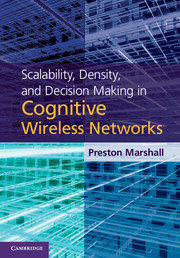Refine search
Actions for selected content:
6791 results in Communications and signal processing

Scalability, Density, and Decision Making in Cognitive Wireless Networks
-
- Published online:
- 05 December 2012
- Print publication:
- 08 November 2012
Contributors
-
- Book:
- Principles of Cognitive Radio
- Published online:
- 05 December 2012
- Print publication:
- 15 November 2012, pp xiii-xiv
-
- Chapter
- Export citation
Contents
-
- Book:
- Principles of Cognitive Radio
- Published online:
- 05 December 2012
- Print publication:
- 15 November 2012, pp vii-xii
-
- Chapter
- Export citation
Preface
-
- Book:
- Principles of Cognitive Radio
- Published online:
- 05 December 2012
- Print publication:
- 15 November 2012, pp xv-xvii
-
- Chapter
- Export citation
Bibliography
-
- Book:
- Principles of Cognitive Radio
- Published online:
- 05 December 2012
- Print publication:
- 15 November 2012, pp 259-294
-
- Chapter
- Export citation
2 - Capacity of cognitive radio networks
-
- Book:
- Principles of Cognitive Radio
- Published online:
- 05 December 2012
- Print publication:
- 15 November 2012, pp 41-101
-
- Chapter
- Export citation
Acknowledgments
-
- Book:
- Principles of Cognitive Radio
- Published online:
- 05 December 2012
- Print publication:
- 15 November 2012, pp xviii-xviii
-
- Chapter
- Export citation
1 - The concept of cognitive radio
-
- Book:
- Principles of Cognitive Radio
- Published online:
- 05 December 2012
- Print publication:
- 15 November 2012, pp 1-40
-
- Chapter
- Export citation
Index
-
- Book:
- Principles of Cognitive Radio
- Published online:
- 05 December 2012
- Print publication:
- 15 November 2012, pp 295-299
-
- Chapter
- Export citation
5 - Spectrum exploration and exploitation
-
-
- Book:
- Principles of Cognitive Radio
- Published online:
- 05 December 2012
- Print publication:
- 15 November 2012, pp 184-258
-
- Chapter
- Export citation
3 - Propagation issues for cognitive radio
-
-
- Book:
- Principles of Cognitive Radio
- Published online:
- 05 December 2012
- Print publication:
- 15 November 2012, pp 102-149
-
- Chapter
- Export citation
4 - Spectrum sensing
-
- Book:
- Principles of Cognitive Radio
- Published online:
- 05 December 2012
- Print publication:
- 15 November 2012, pp 150-183
-
- Chapter
- Export citation
Frontmatter
-
- Book:
- Principles of Cognitive Radio
- Published online:
- 05 December 2012
- Print publication:
- 15 November 2012, pp i-vi
-
- Chapter
- Export citation
Notation
-
- Book:
- Principles of Cognitive Radio
- Published online:
- 05 December 2012
- Print publication:
- 15 November 2012, pp xix-xxvi
-
- Chapter
- Export citation
Part VI - Appendices
-
- Book:
- Scalability, Density, and Decision Making in Cognitive Wireless Networks
- Published online:
- 05 December 2012
- Print publication:
- 08 November 2012, pp 315-316
-
- Chapter
- Export citation
11 - Network sensing and exchange information effectiveness
- from Part III - System performance of cognitive wireless systems
-
- Book:
- Scalability, Density, and Decision Making in Cognitive Wireless Networks
- Published online:
- 05 December 2012
- Print publication:
- 08 November 2012, pp 191-201
-
- Chapter
- Export citation
2 - Theoretical foundations
- from Part I - Overview
-
- Book:
- Scalability, Density, and Decision Making in Cognitive Wireless Networks
- Published online:
- 05 December 2012
- Print publication:
- 08 November 2012, pp 18-52
-
- Chapter
- Export citation
XXI - Sequences, Functions, Spaces
- from C - APPENDIX
-
- Book:
- The Theory of Probability
- Published online:
- 05 December 2012
- Print publication:
- 08 November 2012, pp 771-788
-
- Chapter
- Export citation
14 - Awareness structure for cognitive wireless systems
- from Part IV - Integrated awareness and decision making
-
- Book:
- Scalability, Density, and Decision Making in Cognitive Wireless Networks
- Published online:
- 05 December 2012
- Print publication:
- 08 November 2012, pp 233-251
-
- Chapter
- Export citation
IX - The Essence of Randomness
- from A - ELEMENTS
-
- Book:
- The Theory of Probability
- Published online:
- 05 December 2012
- Print publication:
- 08 November 2012, pp 275-314
-
- Chapter
- Export citation
